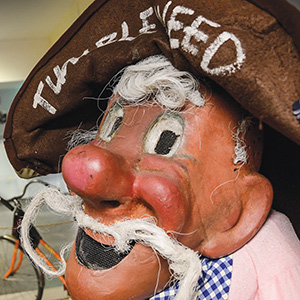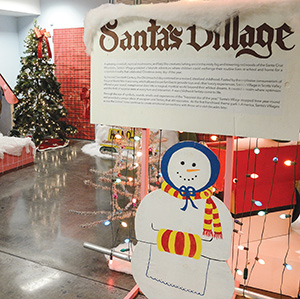Features & Columns
Forgotten Frontier
roamed freely through fantastical landscapes
 HOWDY PARDNER: Tumbleweed, one of the characters from Frontier Village, greets visitors to the 'It Takes A Village' exhibit at NUMU Los Gatos.
HOWDY PARDNER: Tumbleweed, one of the characters from Frontier Village, greets visitors to the 'It Takes A Village' exhibit at NUMU Los Gatos.
A few weeks ago, Los Gatans heard a revolver's sharp crack cut through the murmur of cars whizzing by on Highway 17. The shot came from a turn-of-the-century Colt, fired just once by a man named Chuck Lowe.
The scene was orchestrated by Amy Long, history curator at the New Museum Los Gatos. It was a test, conducted in the hopes of acquiring a permit to recreate a theatrical, Old West-style shootout on the opening day of the museum's latest exhibit, "It Takes A Village"—a historical retrospective on three of the South Bay's beloved and now-defunct theme parks: San Jose's Frontier Village and a pair of Scotts Valley attractions, Santa's Village and Lost World.
Long's initial plan was to have original Frontier Village gunfighters, including Lowe, engage in fake duels—blowing each other away in the plaza, right out front of the museum and Los Gatos Library, exactly as they did 40 years ago at Frontier Village. But the report of Lowe's pistol, which was loaded with blanks, alarmed too many residents living in NUMU's vicinity and calls were placed to the Los Gatos Police Department, which put the kibosh on Long's proposal.
Long isn't worried, however. The calls of concern over the gunshot have been far outpaced by enthusiastic correspondence for the exhibit, which opens Saturday.
"Hundreds of people are emailing me photos," Long says. "I've been posting about this on social media for months, and I could tell you that I've never seen such a response from the general public over a show than this one."
GOOD OLD DAYSIt makes perfect sense that those who remember the heyday of Frontier Village would yearn for those good old days. These theme parks came about during a time characterized by skyrocketing consumerism, full-swing optimism and giddy tippytoe euphoria. America had defeated the Nazis, triumphed over Japan and stood atop the world. The automobile era was here to stay and the American Dream manifested itself in tract-house subdivisions from coast to coast. The high standard of living, combined with the baby boom, meant that the '50s would become a child-centric decade.
In an increasingly commercialized era, parents and grandparents spent more time and money on children than ever before. According to a text panel in the show, toy sales soared from $84 million in 1940 to $1.25 billion in the '60s, resulting in a culture of creative play and imagination. In the same way that children's books provided alternate realities via pictures, Frontier Village, Santa's Village and Lost World provided similar realities via sight, smell, sound and experience.
 GOOD OLD DAYS: Memorabilia from the Lost World, Frontier Village and Santa's Village theme parks on display at the NUMU exhibit, 'It Takes A Village.' Photograph by Greg Ramar
GOOD OLD DAYS: Memorabilia from the Lost World, Frontier Village and Santa's Village theme parks on display at the NUMU exhibit, 'It Takes A Village.' Photograph by Greg Ramar
Even as more Americans were able to access the good life through an expanding middle class, communities were still tightly knit and homogeneous. The counterculture revolution—with its drugs and radical politics—had yet to blossom, and San Jose was still known as The Valley of Heart's Delight. The possibilities seemed endless and endlessly good. And that led to a certain style of parenting that seems foreign to many new parents.
According to NUMU Executive Director Lisa Coscino, children of her generation were often allowed to roam around theme parks, like Frontier Village, unaccompanied by adults for an entire day. "There wasn't so much fear," she says, and as a result, "children learned how to solve their own problems when they were left alone—unlike with contemporary helicopter parenting."
Today, Coscino says, the world is a much scarier place, and children stay indoors, playing video games and chatting on their handheld devices, expressing themselves with emojis instead of real emotions.
Coscino is disappointed that there will be no Mexican standoff outside of the museum. She's also bummed that Lowe, who once worked as a "Marshal" at Frontier Village, will not be permitted to carry his sidearm—even unloaded—around the exhibit, as he does not have an open carry permit. However, she fully understands the department's decision. In fact, Coscino is embracing the episode as a teachable moment.
"One of the things that it points to is kind of what this exhibit is talking about, really," she says. "Besides being a trip down memory lane, this exhibit is an investigation into childhood nostalgia and into mid-century lifestyle dynamics, versus what is happening right now."
PAST PRESENTWalking around the basement of NUMU, Long steps on strands of hay. She points to a pair of old-west-style saloon doors, the swinging type, which will beckon visitors into the new exhibit, whose full title is: "It Takes a Village: A trip back in time to Frontier Village, Santa's Village, and Lost World."
"People will walk in through those doors," Long says, explaining that the doors came from Shaughnessy McGehee's backyard re-creation of Frontier Village.
As we tromp through the space, piles of artifacts in various stages of preparation surround us: original Frontier Village fence material, six-shooters, marshals badges, employee documents, maps, bicycle parts and a cactus. Sections of the exhibit will pay tribute to park characters Tumbleweed, Indian Jim and the Lost Dutchman Mine Ride. "The Memory Wall" will enable former visitors and employees to scribble their recollections of Frontier Village in chalk.
Summer Winds Nursery in Campbell supplied the bales of hay, but much of the bigger pieces of Frontier Village lore either came from McGehee's backyard or the obsessive collection of Tim Stephens. Countless other donors, inseparable from their own Frontier Village nostalgia, are relentlessly throwing in their two cents.
While Frontier Village comprises the bulk of the show, two other theme parks, Santa's Village and Lost World, also receive their due. Both were located in Scotts Valley, just off Highway 17. Long recently rescued a giant bear from a City of Scotts Valley storage depot. Originally from Lost World, the bear now sits in one corner of the exhibit, its paint flaking off from decades of neglect. Wayne Thompson, son of the couple that started Lost World, contributed a giant lion.
The Santa's Village portion of the exhibit features a large wooden cutout of Santa Claus—not originally part of the park, but from the same era—and a hand-cranked rail car, made to look like a sled. Coscino shakes her head in wonder at the tiny vehicle, which has no seat belt and is clearly built for a single child operator.
Today, the rickety contraption would cause an ambulance-chasing lawyer to salivate, but back in her day, this was par for the course at amusement parks, Coscino says....
THE ARCHITECTFrontier Village was the brainchild of Joe Zukin. Originally from Los Angeles, Zukin relocated to the South Bay in 1943 to attend business school at Stanford. By 1949, he was already demonstrating his entrepreneurial spirit by opening one of San Jose's first self-service gas stations, at the corner of Santa Clara and Montgomery, right about where the Shark Tank now sits. A few years later, he started opening car washes. Both endeavors were new ideas at the time.
When Disneyland debuted in 1955, Zukin took a crew of interested parties down south to see what the place looked like. The Happiest Place on Earth was only a primitive version of what it is today. However, at the time, the idea that an amusement park could be "family friendly" was quite novel. Prior to Disneyland, amusement parks were centered around carnival rides or seaside resorts. Generally speaking, these parks were geared toward young bachelors, served alcohol and were much seedier in nature—a far cry from the squeaky clean Magic Kingdom.
Zukin and his traveling companions—Mike Khourie, Hawley Smith and John Poole—were impressed. They wondered if they could duplicate Disney's product in the Bay Area. While in Anaheim, the group grew especially fond of the Frontierland portion of the park and soon conspired to pool their resources around starting a brand new Western-style theme park.
"That was the germ of it," Zukin recalls. "From there, we raised money, found artists and applied for a permit to sell stock to the public."
He and his team sold around $1 million of stock in 1959 and '60. Frontier Village was opened in 1961.
The late Laurie Hollings designed much of how the park actually appeared to guests. A Jack of all trades, Hollings brought many talents to the table. He was an illustrator, visual artist and engineer with experience designing movie sets and amusement park rides.
"I owe a lot of the park's success to him," Zukin says of Hollings, who passed away about a decade ago. "He had the feeling, he understood what people liked. He put things in the right place."
Everything—from the park's train station, to the trees and foliage lining the pathways, to the animals Hollings had roaming the grounds—all worked together to form a frontier fantasy land. Wild West cliches and hoary stereotypes aside, Frontier Village hit its mark. It was safe, clean and provided children a world of seemingly limitless possibility—pulling the worlds of Bonanza and Gunsmoke out of the TV and making them real. Each microcosm within the park invited kids and their parents to bond over activities like trout fishing, canoe rides, archery and gaslight theater-type stage shows...continue reading


